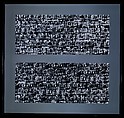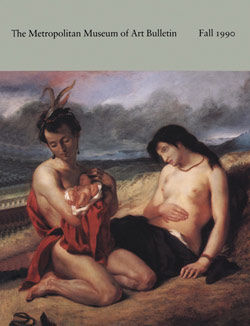Port Authority
Ray K. Metzker American
Not on view
Schooled at Chicago's Institute of Design, Ray Metzker inherited European traditions of formal experimentation brought to America by the school's founder, László Moholy-Nagy. Starting with the premise of the plasticity of his medium, Metzker rejected the prevailing notion that to photograph is to frame and thus to fix a unit of optical truth. Instead, he devised a way to use rolls of film, not single frames, as negatives. For "Port Authority" he exposed the film twice, once inside and once outside New York's bus station. The unaligned, double-exposed frames that resulted point to the seamless continuity of overlapping and interpenetrating realities of urban life.
To further indicate the complex contiguity and the chance simultaneity of metropolitan experience, Metzker arranged twelve prints from the film rolls into two panels that float one above the other. These six-part strophic variations have a strong graphic beat and complex internal repeats informed by the artist's keen interest in kinetic sculpture and percussive movement.
"Port Authority" is one of the last fifteen unique composites Metzker made between 1964 and 1967. In line with contemporary developments in Conceptual, Pop, machine, Op, and performance art, these large wall-sized works uncannily merge the crucial artistic issues of the 1960s. Their technical innovation and intellectual integrity remain unsurpassed, providing a precocious challenge to current photographic practice.
Due to rights restrictions, this image cannot be enlarged, viewed at full screen, or downloaded.


